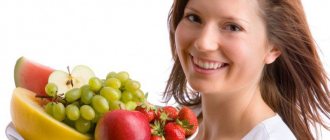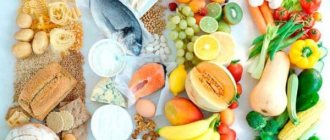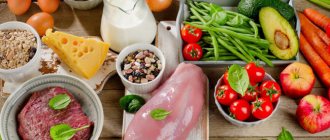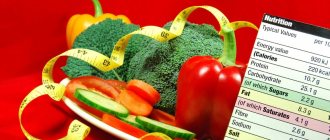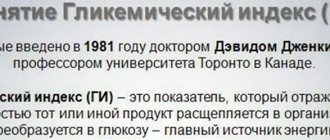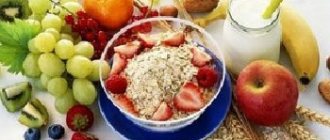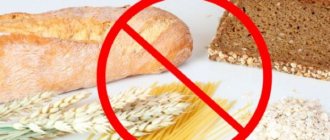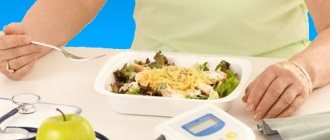Find out more
( 2 ratings, average: 5.00 out of 5)
Candidiasis is a yeast disease caused by the Candida albicans strain. The first symptoms of the development of thrush may be itching of the mucous membrane, burning, the appearance of white discharge similar to cottage cheese, and irritation. Then inflammation and dryness appear. This disease is not dangerous, but it causes a lot of discomfort to a person for a long time. A diet for thrush will help not only cope with the symptoms, but also forget about this problem forever.
Risk factors, causes and symptoms
There are more than 20 species of Candida fungi that can cause infection in humans. The most common is Candida albicans, a single-celled fungus that is always present in the genital and intestinal tracts. Candida yeast usually lives on the skin and mucous membranes without causing infection, but an overgrowth of these organisms can cause problematic symptoms to develop in the body. Some risk factors for candida include diabetes, conventional cancer treatments, and treatment of asthma with corticosteroid inhalers. According to official data, there are about a dozen recognized causes of microbiome dysfunction and candida overgrowth. There may be several reasons for the appearance of candidiasis:
- Changes in normal hormonal balance, including pregnancy, birth control pills, and estrogen therapy. Fluctuations in hormonal levels lead to the fact that the immune system cannot cope with such a load and gives weakness, which the yeast takes advantage of.
- Frequent use of antibiotics that kill beneficial bacteria of the mucosal microflora. Therefore, after completing a course of treatment without the use of probiotics, thrush appears.
- Uncontrolled diabetes, which can cause high sugar levels (it stimulates yeast growth).
- A sharp decrease in immunity. There may be several factors here, ranging from long-term illness to increased physical activity, overwork, and other factors.
- Obesity of various degrees. The sweat that forms on the skin is an excellent breeding ground for candidiasis.
- Tight-fitting and synthetic clothing that retains moisture and warmth. Fabric based on synthetic threads, which fits tightly to the body, can disrupt the natural microflora, which results in thrush.
- Violation of personal hygiene. A diet for thrush in women will not help if you do not follow the rules of personal hygiene. Yeast can enter the body in various ways, from transport to public places. To avoid problems, you need to regularly wash your hands with soap, use antiseptics, and wash your clothes with high-quality products.
- Nutrition problems, insufficient amounts of nutrients, vitamins, minerals.
- Increased consumption of alcoholic beverages, smoking.
- Drinking tap water. Its exact composition remains unknown, and some substances may have a negative impact on overall health.
- The occurrence of stressful situations that negatively affect the entire body as a whole.
- Environmental disturbances and the entry of harmful chemicals into the body with further poisoning.
- Allergic reactions. May also be the cause. This could be new washing powder, unsuitable clothing fabric or shower gel, sanitary pads and tampons. Recently, many people have experienced a reaction in the form of thrush after contact with latex, visiting a gynecologist, etc.
Find out the causes of excess weight and ways to quickly lose weight
Sign up for a free initial appointment with a nutritionist!
According to recent studies, it is possible to cope with thrush and prevent its occurrence not only with medication. A properly structured diet for candidiasis and the use of probiotic complexes will allow you to forget about this problem once and for all. And it all started with the fact that sugar is recognized as the main nutrient medium for the development of this yeast strain.
- As soon as this strain of yeast appears in the mucous membranes, a sharp craving for sweets appears, bad breath, a white coating on the tongue, dizziness and nausea, hormonal imbalance, joint pain, loss of libido, chronic problems with the sinuses and allergies, problems with digestion. Symptoms may worsen in damp or moldy environments or after eating foods containing sugar or yeast. If left untreated, thrush will weaken the immune system, opening the door to more serious illness.
It should be noted that candidiasis cannot be gotten rid of so easily. There are a number of side effects caused by this disease, as well as by eliminating the cause. These include impaired brain function, headache, fatigue, dizziness, intestinal problems including bloating, gas, constipation and nausea, sweating and fever, skin problems, and typical flu symptoms. On the subject: Diet for vascular atherosclerosis All this usually goes away in 7-10 days. Within a few weeks, you will notice an increase in energy and attention, as well as relief from other symptoms. Therefore, when the so-called “withdrawal syndrome” begins in the area of harmful yeast, it’s time to celebrate, because soon it will all be gone, once and for all, thanks to the diet for candidiasis of the intestines and other organs.
Recurrent candidiasis
In the chronic course, during the period of remission, the clinical manifestations of the disease are blurred, but at the time of relapse, the symptoms worsen and in intensity resemble acute candidiasis. Recurrent candidiasis during an exacerbation can be recognized by the following symptoms:
- Itching, discomfort. They can be felt both on the surface of the external genitalia and inside the vagina. Often itching and discomfort are accompanied by redness and swelling of the mucous membrane.
- Pain, burning when urinating. In those areas where the largest number of fungi are localized, burning and pain are felt more intensely, but the maximum symptoms appear upon contact with urine, which further irritates the affected mucosa.
- White or slightly yellowish discharge with a cheesy consistency. A recurrence of thrush can manifest itself as either intense or scanty discharge of an unpleasant, sour odor. It is worth noting that not all vaginal discharge indicates candidiasis. Therefore, in order to determine an accurate diagnosis, you need to submit a sample for laboratory testing, which will help identify the pathogen.
In addition to the characteristic signs of candidiasis, during a relapse a woman may experience other unpleasant symptoms:
- excessive vaginal dryness;
- discomfort, pain during sexual intercourse;
- formation of cracks and erosions on the mucous membranes of the genital organs and vaginal walls;
- nagging, aching pain in the lower abdomen.
How to switch to an anti-thrush diet?
First of all, you need to normalize your sugar level and cleanse your body of waste and toxins that have accumulated in the intestines and other organs for years. The first stage lasts about 2 days, and during this period you can only drink natural vegetable broth (liquid only), plain clean water. This drinking regimen will help remove toxins. In the second stage of cleansing, which lasts from 3 to 5 days, grains, sugars, fruits, starches and alcohol should be eliminated from the diet. It is best to eat only boiled and stewed vegetables. It is worth moderating the amount of potatoes, radishes, beets and other starchy vegetables. You need to continue to drink plenty of water. During any of the cleanses, bentonite clay can be used to help draw out toxins and effectively remove them from the body's system.
Cost of treatment
Prices for the treatment of recurrent thrush in a medical clinic are available to every patient in need of professional medical care. In their work, our specialists practice modern methods of therapy, guaranteeing safety and effective results.
Gynecology
| Name of service | Price, rub.) | Discount |
Consultation
| Name of service | Price, rub.) | Discount |
| Appointment with a gynecologist (without examination), primary | 1400 | |
| Appointment with a gynecologist (examination, consultation), repeated | 1400 | |
| Appointment with a gynecologist (examination, consultation), primary | 1600 | |
| Consultation with a gynecologist-endocrinologist | 1600 | |
| Appointment with an obstetrician-gynecologist for pregnancy (examination, consultation), primary | 1700 | |
| Appointment with an obstetrician-gynecologist for pregnancy (examination, consultation), repeated | 1400 | |
| Consultation with a gynecologist on the selection of contraception | 1600 | |
| Consultation with a gynecologist on infertility issues | 1600 | |
| Consultation with a specialist with registration of a certificate of incapacity for work | 1600 | |
| Daily management of the patient according to the certificate of incapacity for work for 1 day | 300 | |
| Registration of a certificate of incapacity for work for pregnancy and childbirth | 6500 | |
| Control examination (Performed after a course of conservative, minimally invasive or surgical treatment) | 800 | |
| Treatment consultation based on examination results (selection of an individual treatment regimen): 1 disease | 1000 | |
| Individual treatment regimen: mix | 2000 | |
| Individual treatment regimen: 1 disease | 1000 | |
| Medical examination by an obstetrician-gynecologist for pregnancy, WITHOUT attachment | 1500 |
Survey
| Name of service | Price, rub.) | Discount |
| Extended colposcopy | 1500 | |
| Advanced video colposcopy | 1700 | |
| Aspiration biopsy of the endometrium (Pipel biopsy) | 2000 | |
| Cervical biopsy | 3000 |
Treatment
| Name of service | Price, rub.) | Discount |
| Chlamydia from 1 to 4 categories. difficulties | 7000-14000 | |
| Trichomoniasis from 1 to 4 categories. difficulties | 5000-7000 | |
| Candidiasis from 1 to 4 categories. difficulties | 4000-8000 | |
| Gardnerellosis from 1 to 4 categories. difficulties | 4000-8000 | |
| Mycoplasmosis / ureaplasmosis from 1 to 4 categories. difficulties | 6000-12000 | |
| Bacterial urethritis from 1 to 4 categories. difficulties | 4000-9000 | |
| Treatment of inflammatory diseases of the female genital organs from 1 to 4 categories. difficulties | 4000-12000 | |
| Antiviral treatment from 1 to 4 categories. difficulties | 8000-12000 | |
| Treatment of infertility of inflammatory origin from 1 to 4 categories. difficulties | 8000-14000 | |
| Treatment of single genital warts/papillomas (cost per unit) | 700 | |
| Treatment of genital warts/papillomas: multiple from 1 to 4 categories. difficulties | 2500-5500 | |
| Treatment of genital warts/papillomas: condylomatosis | 9500 | |
| Treatment of cervical dysplasia using radiosurgery | 3500 | |
| Treatment of cervical erosion by radiosurgical method from 1 to 3 categories. difficulties | 3500-7000 |
Manipulation
| Name of service | Price, rub.) | Discount |
| Postoperative dressing | 800 | |
| Cardiotocography (CTG) during multiple pregnancy | 2500 | |
| Cardiotocography (CTG) of the fetus | 1900 | |
| Rikta | 350 | |
| Nova-Ring insertion/removal | 500/500 | |
| Instillation of a mud tampon | 400 | |
| Opening a vaginal cyst | 2500 | |
| Opening and draining the boil (perineum) | 1500 | |
| Opening of abscess of the Bartholin gland from 1 to 4 categories. difficulties | 5000-10000 | |
| Opening of nabothian cysts using radiosurgical method (for 1 pc.) | 1000 | |
| Drug treatment of cervical diseases (solkovagin) | 2500 | |
| Diathermocoagulation of cervical diseases | 2500 | |
| Cryodestruction of cervical diseases | 2500 | |
| Cryodestruction of benign tumors of the external genitalia | 700 | |
| Cryodestruction of papillomas | 1000 | |
| Insertion of an intrauterine device provided by the Customer | 2500 | |
| Insertion of the Mirena intrauterine device (excluding the cost of the IUD) | 2500 | |
| Spiral "Mirena" | 15000 | |
| Insertion of an intrauterine device provided by the Contractor: “Multiloud” device | 4000 | |
| Removal of the intrauterine device, uncomplicated/complicated | 1500/2500 | |
| Removal of foreign bodies from the vagina, uncomplicated/complicated | 1200/2000 | |
| Instillation of the drug | 300 | |
| Treatment of the external genitalia | 500 | |
| Vaginal/cervical treatment | 500 | |
| Therapeutic bath with medicine | 500 | |
| Vaginal sanitation | 500 |
Switching to a thrush diet
After the cleansing stage is completed, you can move on to an antifungal diet, which not only prevents the development of candidiasis, but also helps the body get rid of this disease forever. The diet consists of several stages.
Refusal of problematic products
First of all, you need to continue to remove foods from your diet that are literally a breeding ground for candida and stimulate its growth in the body. Common pathogens include sugar, white flour, yeast and alcohol. These foods are thought to promote the growth of candida. If you avoid sugar and white flour, you can easily avoid most other processed foods, which tend to be higher in calories, unhealthy ingredients, and lower in nutrients. Avoiding sugar in all its different forms is truly the key to a candida diet in women. Yeast cells need sugar to build cell walls, reproduce, and transform into a more dangerous fungal form. This is why a low sugar diet is such a necessary part of treatment. The diet should focus on vegetables, high-quality protein foods, and gluten-free grains such as brown rice and millet. Avoiding fruits during this time is also usually recommended because although fruits are very healthy, they turn into sugar in the body. As for vegetables, you should also avoid these sweet, starchy vegetables: potatoes, carrots, sweet potatoes, beets, peas. These vegetables are prohibited in a strict anti-candida diet due to their high carbohydrate content, but they are certainly rich in nutrients and can be introduced into the diet later.
Strengthening the immune system
There are 10 special foods to include in your daily list to boost your immune system and inhibit yeast growth, including apple cider vinegar, sauerkraut and other fermented vegetables, green vegetables and green drinks, coconut oil, honey, garlic, flaxseed and oil, natural cranberry juice, fermented milk products, as well as spices such as turmeric and cinnamon. On the subject: Why you can’t eat after 6 pm To achieve results with this diet for candidiasis of the esophagus and other organs, you need from several weeks to several months. This depends on a few key elements:
- How strictly is the diet followed?
- Consumption of probiotics and antifungals.
- Patient's immunity.
- Tendency to such diseases and lifestyle.
Of course, you shouldn’t forget about personal hygiene, the right choice of antifungal agents, consultation with your doctor, smoking and other bad habits that also affect the effectiveness of the diet.
Reintroduction of Prohibited Products
As soon as the first results are visible and the thrush begins to recede, many break down and return to their previous diet and lifestyle. Naturally, thrush reappears on the horizon. To prevent this from happening, you need to gradually introduce some foods back into your diet. Low-sugar fruits like green apples are a great example of smart choices. If reintroduced foods do not aggravate candidiasis symptoms, you can continue to check the list further. You can introduce approximately one product every 3-4 days in order to closely monitor the body’s reaction and, if anything, immediately abandon the problematic food. There is a basic list of products that are recommended to be included in your daily diet for the prevention and treatment of candidiasis:
- Apple vinegar. The acid and enzymes in apple cider vinegar help rid the body of excess yeast.
- Sauerkraut. Fermented foods, such as sauerkraut, contain microflora that help protect the intestines. Regular consumption can help improve the immune system, making the body less susceptible to candida.
- Green vegetables and green drinks. Leafy green vegetables help combat the acidic nature of yeast overgrowth. Greens are sugar-free but contain high levels of magnesium to naturally detoxify the body, vitamin C to strengthen the immune system, chlorophyll to cleanse the body, B vitamins to energize, and iron for overall support.
- Coconut oil. It has antimicrobial properties, and the combination of lauric and caprylic acids contained in coconut oil kills harmful microflora when consumed and applied topically.
- Stevia. Stevia is an ideal choice for those on a diet, as it is an excellent substitute for sugar, sweetening foods. Stevia is not only antifungal, anti-inflammatory and antibiotic, but also helps balance the pancreas.
- Garlic. Contains a large number of sulfur-containing compounds that have extremely strong broad-spectrum antifungal properties. Raw garlic is especially useful for fighting thrush.
- Ground flax seeds. The polyphenols found in flax seeds support the growth of probiotics in the gut and may also help eliminate candida in the body.
- Unsweetened cranberry juice. Cranberry juice without added sugar helps adjust urine pH levels, helping prevent fungal overgrowth.
- Dairy products. Cultured dairy products, preferably kefir, can effectively destroy candida in the body and promote the growth of healthy microflora.
- Spices such as turmeric and cinnamon. A diet for the treatment of candidiasis is impossible without spices. Turmeric contains an active ingredient called curcumin, which has been shown to completely inhibit the growth of Candida albicans (as well as many other fungal strains). Cinnamon may treat thrush because studies have shown that people who consume cinnamon tend to suffer from this condition much less frequently.
- Cooked vegetables. Non-starchy cooked vegetables such as broccoli, cauliflower and asparagus contain valuable nutrients that fight thrush.
- Meat of natural origin. Protein plays a key role in an anti-thrush diet. If you obtain protein from factory-raised meat, you may not fully know what auxiliary products and substances were used and how they will affect the development of thrush. That's why it's important to eat only organic meat.
- Bone broth. Beneficial for many aspects of health. This is one of the best sources of candida-killing substances due to the positive effects of the broth on gut health.
Healthy drinks
The number one drink in all diets is clean drinking water. Nutrition for thrush is no exception, because during its treatment the body tries to cleanse itself of toxins - waste products of Candida fungi. Therefore, it is advisable to drink plenty of fluids, not forgetting to strengthen the immune system. Thus, the norm of clean drinking water varies from 1.5 to 2 liters. Natural freshly squeezed juices (including grapefruit, carrot, tomato), rosehip infusion, cranberry and lingonberry fruit drinks, which have a high content of vitamin C, are useful. It is worth including a chicory drink in your diet; infusions of hawthorn, rowan, sage, plantain, string, eucalyptus; compotes, chamomile tea.
Is it possible to drink coffee and tea? This is a pressing question for many. The answer to this is most likely in the affirmative, but with some reservations. It is permissible to consume only natural ground coffee and only a small amount per day. It is better to prefer green tea to black tea.
List of prohibited products
During a diet for candidiasis, the menu is supplemented with a list of foods that need to be completely or at least partially abandoned.
- Sugar and sugar alternatives. These sweet foods are a breeding ground for yeast and should be avoided at all costs and not consumed in any quantity. Even one gram is enough to start processes.
- Fruits and fruit juices. Although fruits are generally healthy, they are high in sugar and can aggravate the body's mucous membranes. Even the most ordinary apples will contain enough sugars for yeast to begin to actively reproduce. A colony can grow from several hundred cells to thousands in just a day, after which the first alarming symptoms begin to appear.
- Alcohol. Most alcoholic drinks contain yeast, so it's no surprise that they should be avoided. This applies not only to beer, but also to wine, as well as other naturally fermented products.
- Cereals. Grain carbohydrates, when absorbed by the body, are broken down into sugars and can become a breeding ground for candida, yeast and harmful bacteria. Even bread contains enough carbohydrates to start a long and very unpleasant illness, so it is better to abstain from all this.
- Peanut. It can often contain mold cells, which only promote the growth of candida. Additionally, peanut allergies are one of the most common food allergies on the planet, which is another reason to avoid them.
- Dairy products. If these are not fermented or fermented milk products, then they should be avoided, at least in the initial stages. Milk contains lactose, which is a sugar. And this applies not only to fresh milk, but also to powdered milk, cheeses, etc. Goat milk products are not as harmful as cow milk products, which should be taken into account.
- Food intolerance. Some fungal infections are caused by food allergies. You should try to avoid foods that cause negative reactions of any kind. If you have food allergies or sensitivities, you should avoid these foods.
You also need to limit the consumption of dried fruits, bananas, milkshakes and juices. To improve your overall condition, it is also recommended to use some essential oils (oregano, myrrh, lavender). But before you start experimenting with oils, you need to do all the necessary allergy tests, since a reaction can occur to any component. Mixing a couple drops of clove or lavender oil with coconut oil during the cleansing phase can speed up the destruction of candida cells. However, since these essential oils are quite powerful, they should only be used for 10 days or less.
For additional useful dietary supplements for thrush in women, the list of products can be expanded somewhat:
- Probiotics. They will give the body healthy bacteria that will help fight yeast.
- Oregano oil (2 drops 3 times daily for 7 days, then stop): Oregano oil is naturally antibacterial and antifungal.
- Garlic (1-2 cloves per day): Helps fight fungal infections and strengthens the immune system.
- Vitamin C (2-3 times daily): Boosts immune function and helps fight infections.
Dinner is served!
Sample menu for the week
Getting pleasure from food, turning every dish into a tasty medicine - this is the principle of culinary tasks and experiments during the treatment of thrush and consolidating its results.
Monday
Breakfast - buckwheat porridge, green tea with lemon. 2nd breakfast - yogurt, biscuits Lunch - vegetable soup with chicken broth, boiled chicken breast, herbal tea. Afternoon snack - green apple. Dinner - green salad dressed with olive oil and lemon juice, boiled chicken liver, chamomile tea.
Tuesday
Breakfast - low-fat cottage cheese with seasonal berries, green tea. 2nd breakfast - fruit salad. Lunch - salad of tomatoes and onions, boiled veal, rosehip infusion. Afternoon snack - fresh grapefruit. Dinner - bell peppers stewed with onions and tomatoes, steamed turkey fillet, herbal infusion.
Wednesday
Breakfast - oatmeal with water, green tea. 2nd breakfast - apple baked with berries. Lunch - salad of cabbage, celery, dill, seasoned with flaxseed oil; turkey stewed with herbs, compote. Afternoon snack - a cup of herbal tea. Dinner - steamed fish, mashed potatoes, a cup of chicory.
Thursday
Breakfast - egg, toast, green tea with lemon. 2nd breakfast - yogurt. Lunch - vegetable puree soup, peppers stuffed with beef and brown rice, fruit juice. Afternoon snack - nuts. Dinner: cottage cheese casserole, chamomile tea.
Friday
Breakfast - omelet with tomatoes, green tea. 2nd breakfast - favorite fermented milk product. Lunch - vegetable soup; fish cooked with lemon in foil, fresh juice. Afternoon snack - pear. Dinner - cabbage rolls, rosehip infusion.
Saturday
Breakfast - millet porridge, fruit tea. 2nd breakfast - yogurt. Lunch - seafood, green salad. Afternoon snack - yogurt, crackers. Dinner - seaweed salad, fish cakes, green tea.
Basic recipes for the diet
With such a set of products that are allowed during the diet against thrush, you will want something non-standard, certain recipes. Of course, you can make it regularly by mixing different types of vegetables. Don't forget to add products from the list. It is also suggested to eat standard Korean side dishes such as carrots, celery, cauliflower, seaweed and other foods prepared in Korean style. This will allow you to significantly diversify your diet. You can also prepare smoothies, salads, and various snacks from vegetables, herbs and some fruits. As soon as thrush occurs, a diet during treatment will allow you to set the record straight once and for all. Of course, you can always resort to only medicinal methods. But they don’t always work, since the body needs constant help and support. This is the only way to rid your body of harmful fungus and begin to lead a healthy, active and fulfilling life. Candida is, unfortunately, a very common problem for many people. Candida symptoms are often ignored, undiagnosed, or misdiagnosed. An antifungal diet can reduce and eliminate candida and its unpleasant symptoms. Some dietary changes may end up being necessary in the long term if reintroduction of certain foods is not successful. In general, it is always best for your health to avoid sugary and processed foods. Real, whole, living food is the best choice.
Related posts:
Where to start losing weight step by step system
Real stories of losing 20 kg with photos and videos before and after!
How to use ginger for weight loss
Rice diet for weight loss
Are you overweight? Or maybe you’re just a “skinny fat guy”?
Test check yourself:
fact or fiction?
Eating more fruit can improve bone density.
Correct! Wrong!
Consuming foods with plenty of bioavailable calcium improves bone density. Fruits generally do not contain much calcium.
Excess protein accumulates in the muscles, causing them to increase.
Correct! Wrong!
Once the need for protein and energy has been met, excess amino acids are converted to acetyl-CoA, from which they are converted into fatty acids and stored in adipocytes. Therefore, excess protein will not be converted into muscle.
Basics of a therapeutic diet
A balanced diet for candidiasis should include components such as:
- Low-fat varieties of fish and meat;
- Vegetables;
- Chicken eggs;
- Buckwheat.
- Products with antifungal effect.
Complex treatment is most effective with proper nutrition. These ingredients should form the basis of the diet. Experts attach great importance to the number of meals, as well as the temperature of the finished dish. The ideal solution would be to avoid salt and various seasonings.
They irritate the oral mucosa, creating a favorable environment for the growth of pathogenic microflora. Steamed or boiled foods are gentle on the oral cavity.
Antifungal resistance
The outcome of contact with yeast-like fungi of the genus Candida is determined by the state of the human antifungal resistance system. In most cases, such contact represents a transient candidal carriage, when the structures and mechanisms of antifungal resistance ensure spontaneous decontamination of the human body. At the same time, in persons with disturbances in the antifungal resistance system, contact can form both persistent carriage and candidiasis. Thus, candidiasis of the digestive tract has typical features of an opportunistic infection. The disease of candidiasis of the mucous membranes is predetermined by the presence of the so-called fungi of the genus Candida. pathogenicity factors.
In particular, fungal cells can attach to epithelial cells (adhesion), and then, through transformation into a filamentous form (pseudomycelium), penetrate the mucous membrane, even “closed” systems (invasion), and cause necrosis of the tissues of the macroorganism due to the secretion of enzymes - aspartyl proteinases and fospholipases . The listed pathogenicity factors are naturally counteracted by numerous factors of antifungal resistance. In particular, the integrity of the epithelial layer of the digestive tract and mucopolysaccharides are of great importance. The protective role is played by the antagonism of yeast-like fungi and obligate bacteria of the digestive tract, the activity of digestive enzymes and the fungistatic effect of nonspecific humoral factors, such as lysozyme, complement, secretory IgA, transferrin, lactoferrin, etc.
However, the function of phagocytic cells, primarily polymorphonuclear leukocytes, and to a lesser extent, mononuclear phagocytes and natural killer cells, is of decisive importance in the system of antifungal resistance. The specific antifungal humoral response is realized due to the synthesis by B cells of specific anti-candidal antibodies of the classes IgA, IgM, IgG and, to a certain extent, IgE. Finally, the complex cooperation of dendritic and other antigen-presenting cells, helper types 1 and 2, and regulatory cells ensures an adequate specific immune response.
Prebiotics of natural origin
These components also help to cope with fungus in the oral cavity and increase the effectiveness of treatment. Prebiotics, according to experts, are complex polysaccharides that are not digested by enzymes.
As a result, they become excellent food for intestinal microflora and displace pathogenic microorganisms. Fructose-oligosaccharide is rightfully recognized as one of the most famous polysaccharides. Its maximum content was found in:
- Asparagus;
- Bananas;
- Onions and garlic;
- Jerusalem artichoke.
Introducing the above ingredients into your daily diet will reduce the risk of relapse and speed up the recovery process.
Nutrition for acute esophagitis:
In case of exacerbation of esophagitis, diet 1A should be followed for no more than 10 days. This diet is strict and if you stick to it, the symptoms of the disease will stop fairly quickly. As soon as the discomfort and symptoms of exacerbation subside, you can move to table 1B. This table is more complete in nutrients.
Notice!
Acute esophagitis is a contraindication for spa treatment: it is better to go to a hospital.
If you have a chronic
form, then you should regularly
carry out preventive treatment
.
